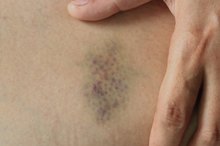How to Treat a Black Eye (Bruise)
How to Treat a Black Eye (Bruise). A "black eye," or bruising of the tissues surrounding the eye, happens when blood "pools" in the affected area.
If you are experiencing serious medical symptoms, seek emergency treatment immediately.
The skin around the eye is very thin and the pooled blood turns the area purplish-blue.
**As time passes, the blood reabsorbs back into the body and the black eye gradually disappears.
** It usually takes about a week for a bruise to go away completely. While you wait, employ a few tips to help treat the area.
Treat the black eye immediately to help reduce the swelling and stop the internal bleeding. Place an ice pack wrapped in a thin cloth on the area above the injured eye, but don't apply too much pressure. If the eye is very swollen and if you are unable to move your eyelids, don't place the ice pack directly on the injured eye. Instead, place the ice just above the eye on the forehead region. You can use some sort of dressing to tape the ice pack into position. Don't leave the pack on for long periods; it is better to use it at 10-minute intervals.
How to Care for a Black & Blue Injury
Learn More
Use vitamin K as another way to treat a new eye bruise. Vitamin K helps to promote and accelerate healing to the tissue. It is readily available in most drugstores and pharmacies. Purchase the 1 to 5 percent vitamin K cream and apply it gently over the affected areas around the eye. Be careful not to get any into the eye socket itself. Another way is to soak a sterile dressing with vitamin K cream or oil and then apply it to the injured eye by taping it in place with dressing. This is a good way to treat the eye because you can wear the vitamin K "eyepatch" while you are sleeping to help healing.
Take over-the-counter acetaminophen if you are experiencing pain from the bleeding or swelling. Do not take aspirin, as it has anticoagulant properties that will prevent the blood from clotting and could make the bruise larger and delay healing.
What to Do for Bee Stings by the Eye?
Learn More
Try an herbal remedy to find some relief for a black eye. The arnica plant and an enzyme in pineapple called bromelain have proven to have healing properties for bruising, for example. As always, consult your health care provider before starting any herbal remedies or alternative treatments.
Use parsley to help treat the black eye. This herb has anesthetic and anti-inflammatory properties and will help the healing process. Grind up some chopped parsley and mix with crushed ice in a blender. Pour the parsley "slurry" mix into ice cube trays and place in the freezer. When the ice cubes are frozen, take a few parsley cubes out of the tray, place onto a soft cotton cloth and apply it to the injured eye as a cold compress. Repeat as necessary, but remember not to leave the cold ice compress on for too long at a time.
Hide your black eye cosmetically while it heals, if needed. Certain types of makeup and foundation are available that are specially formulated to conceal or hide marks and discoloration on the skin. Use the Internet to research some of these products, which can also be purchased online.
Don't blow your nose too forcefully while the black eye is healing or else you risk causing capillaries to begin bleeding again from the force and pressure. If this happens, healing will take longer and the bruising could become larger. A worst-case scenario is that the eye could become infected due to accumulation of blood, especially if the bone of the eye socket was fractured.
Tips
See an ophthalmologist after you have sustained any kind of eye injury. Sometimes the injury might appear superficial and asymptomatic at the early stages, but complications such as retinal detachment or internal hemorrhages could occur later from the injury.
Warnings
Go to the ER or seek immediate medical attention if the eye injury presents with double or blurry vision, dizziness, "floaters" in the eye, pain upon eye movement and severe bleeding that will not stop. The purpose of this article is to educate and inform the reader and is not a substitute for professional medical advice or seeking medical attention from a doctor.
Related Articles
Tips
- See an ophthalmologist after you have sustained any kind of eye injury. Sometimes the injury might appear superficial and asymptomatic at the early stages, but complications such as retinal detachment or internal hemorrhages could occur later from the injury.
Warnings
- Go to the ER or seek immediate medical attention if the eye injury presents with double or blurry vision, dizziness, "floaters" in the eye, pain upon eye movement and severe bleeding that will not stop.
- The purpose of this article is to educate and inform the reader and is not a substitute for professional medical advice or seeking medical attention from a doctor.
Writer Bio
Dr Susan Jewell is a trained doctor and scientist in clinical research medicine, as well as a stem cell scientist in oncology and AIDS/HIV at the National Cancer Institute and UCLA School of Medicine, UCLA Dental Research Institute, and the Yip Head and Neck Cancer Institute. Dr. Jewell received several prestigious awards and fellowships from NIH and UCLA, notably the Cancer Research Training Award and the National Research Scientist Award as well as several scholarships from NIH Graduate School









